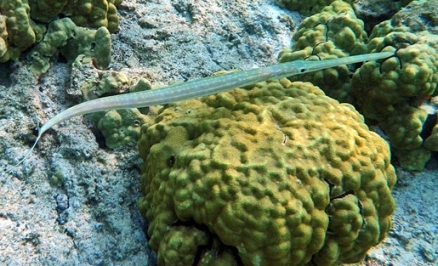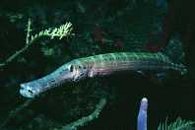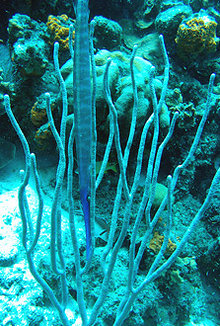Trumpetfish (Ecology)
Contents
Trumpetfish
The trumpetfish (scientific name: Aulostomus maculatus) is a member of the trumpetfish family (Family Aulostomidae) that lives on coral reefs in the Western Atlantic Ocean and Caribbean Sea (Caribbean Sea large marine ecosystem).
|
Scientific Classification Kingdom: Animalia (Animals) |
Physical Description
Trumpetfish range from 0.6 to 1.0 meters in length. They have long thin bodies and get their names from their trumpet-shaped mouth. They are capable of changing color and can have brown, blue or yellow coloration. They have a prominent barbel at the tip of their lower jaw.
Distribution
They are found in the Western Atlantic from southern Florida, USA and Bermuda to northern South America and throughout the Caribbean Sea, east to St. Paul's Rocks.
Habitat
The habitat for this species is chiefly on coral reefs at depths ranging from two to 25 meters. They are commonly found swimming around reefs or hanging snout-down among sea whips (gorgonians).
Feeding Behavior
Trumpetfish are carnivoresthat feed on fish and crustaceans. They are ambush predatorsso theyrely on camouflage and stealth to allow them to get close to potential prey. They often assume a head down position among the branches of soft rods or sea whips and their bodies sway back and forth in the current with the flexible branches in an attempt to hide from their prey. This vertical posture allows them to blend in with sea pens, sea rods and pipe sponges, providing useful camoulflage. Trumpetfish capture their prey by quickly opening their large mouth to create suction that pulls in their prey. Because they are capable of opening their mouths as wide as the diameter of their bodies, they are capable of capturing large prey.
Behavior
Because this species is designed to be an ambush predator, trumpetfish typically hunt by themselves. They may, however, join forces with members of different fish species in an attempt to capture prey. Trumpetfish sometimes join eels in nuclear hunting, a strategy in which the eel hunts for prey inside of the reef while the trumpetfish hunts above the reef. The eel benefits from this partnership because it is able to capture prey that were unable to flee because of the presence of the trumpetfish and the trumpetfish benefit from capturing prey chased from the protection of the reef by the eel.
Trumpetfish occasionally attempt to conceal themselves by using an interesting behavior known as shadowing in which a trumpetfish swims immediately above another large fish such as a parrotfish in an attempt to hide from their prey. Interestingly, trumpetfish of different color morphs appear to shadow fish of similar colors.
Reproduction
Relatively little is known about reproduction in trumpetfish. They are thought to produce pelagic eggs which result in pelagic larvae; those larvae ultimately settle on the reef upper surface.
Associations
Trumpetfish may occasionally hunt with eels (nuclear hunting) or shadow large fishes while feeding.
Conservation Status
The trumpetfishis not considered to be a species at risk.
References and Further Reading
- Encyclopedia of Life. 2011. Aulostomus maculatus Valenciennes, 1841
- Marinebio. 2011. Aulostomus maculatus Trumpetfish
- Jan Rong-Quen. 2000. Resource limitation underlying reproductive strategies of coral reef fishes: a hypothesis . Zoological Studies 38: 266-274.Humann, P. and N. Deloach (Editor), 1994. Reef Fish Identification: Florida, Caribbean, Bahamas. New World Publications, Inc. Jacksonville, FL. ISBN: 1878348078
- N.Deloach. 1999. Reef Fish Behavior, Florida, Caribbean, Bahamas. New World Publications, Inc. Jacksonville, FL. ISBN: 1878348280


